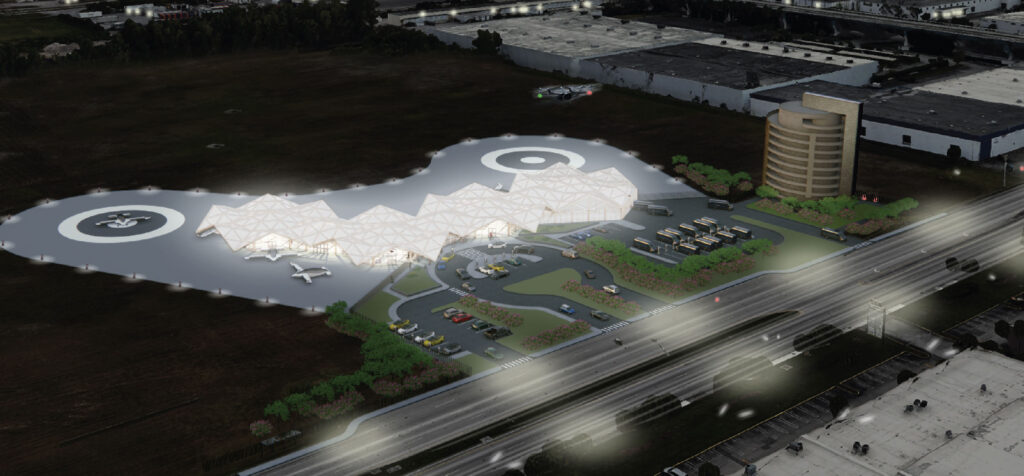Connecting communities equitably with scalable vertiports
As conversations around ESG, social equity and digital connectivity evolve, our global Tech + Logistics team has sought to answer a pressing question: How can innovations and design thinking deliver greater connectivity and equity to the most remote of communities– and provide better digital, health and logistics support than has historically been possible?
New wireless and satellite technologies present an immense opportunity. They can span distances previously uneconomical for traditional fiber access — closing the digital divide and significantly enhancing equity. But physical access matters too. Advanced air mobility (AAM) innovations, including drones and electric Vertical Takeoff and Landing (eVTOL) solutions, can be leveraged to connect more remote communities physically.
Centered around a modular solution that can evolve with time, AECOM’s scalable vertiport concept allows us to consolidate digital and remote connectivity into a single community asset, integrating next generation logistics, healthcare and digital infrastructure. Combining these otherwise separate community functions creates opportunities for common infrastructure, reducing the cost of initial deployment.

Faster connectivity with 5G
The economics of providing fiber to remote communities has historically proven challenging, often resulting in incredibly slow dial up speeds. Satellite or 5G-based internet services, however, mitigate that challenge and bring access to the modern digital ecosystem. By integrating 5G into our vertiport concept, we add another functionality that could then be rolled out to the broader community.
Beyond enhancing the digital experience of its residents, this new connectivity enables innovation in several sectors including healthcare, education and broader economic drivers including employment opportunities, all of which can enhance equity in more isolated towns.
Accessible virtual and in-person healthcare
As the general public’s comfort level with telemedicine has grown exponentially during the pandemic, we could imagine a revolution in service — maybe one involving telemedicine robots in a virtual doctor’s office.
Taking this a step further, 5G wireless networks are expected to bring surgery to the next level. Remote surgery and telemonitoring could be included as part of routine medical care given 5G’s high bandwidth, ultra-short latency, inter-system connectivity, high levels of mobility, availability and reliability.
While digital technologies can reduce the need to physically meet with a doctor, they cannot eliminate the need altogether. Interestingly, air travel already has a history of supporting healthcare within remote areas. Best exemplified by the launch of Australia’s Royal Flying Doctors Service in 1928, an “aerial experiment” enabled equitable healthcare, education, and connectivity to rural communities across the Australian Outback.
AAM brings the opportunity to explore our next “aerial experiment,” bringing a faster, more agile physical connection between healthcare and our communities.
Providing essential logistical support
Many rural communities the world over are served by a single delivery option. Though often infrequent, it remains essential to sustaining the community — providing medication, information and other support.
In the U.S., the United States Postal Service (USPS) fulfils this role and delivers mail across approximately 75,000 rural routes, roughly one third of its total delivery routes. There are 43 million residential delivery points on those routes. It continues to fulfil its 300-year commitment and universal obligation to provide service to every delivery point in the country, regardless of profitability.
It is therefore not surprising that the USPS plays a very central role in smaller and rural communities, where a physical location often serves as much more than just a postal center. It can be a central information center, a meeting point, and a place where essential medicines are delivered.
Integrating AAM strategies not only provides an opportunity to decarbonize the supply chain and provide more economic and consistent service to these remote communities, it may also bring opportunities to extend same-day air offerings, providing more equitable access to everything from school supplies to essential medicines.
Solving for equity
Healthcare and logistics share similar infrastructure needs when deployed in remote locations. Combining them within a single facility is more cost effective to deploy and more economical to operate.
By creating this new community asset and leveraging innovation to enhance the way a community functions, this application of our scalable vertiport concept addresses the lack of core services experienced in rural areas. It also creates a platform through which additional functions such as electric vehicle charging, high performance compute (HPC) or bitcoin mining, for example, could be integrated. Applying our scalable vertiport concept provides a modular solution for a new type of community asset that targets key areas of social inequity – digital, healthcare and logistics connectivity – potentially transforming the quality of life for our remote communities.







